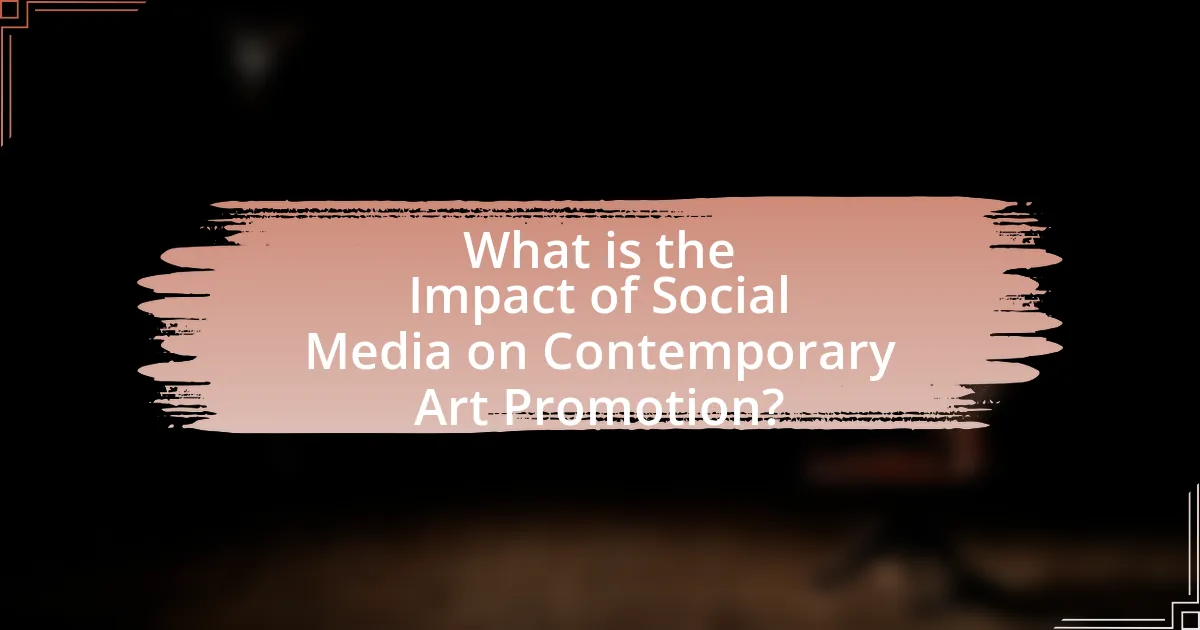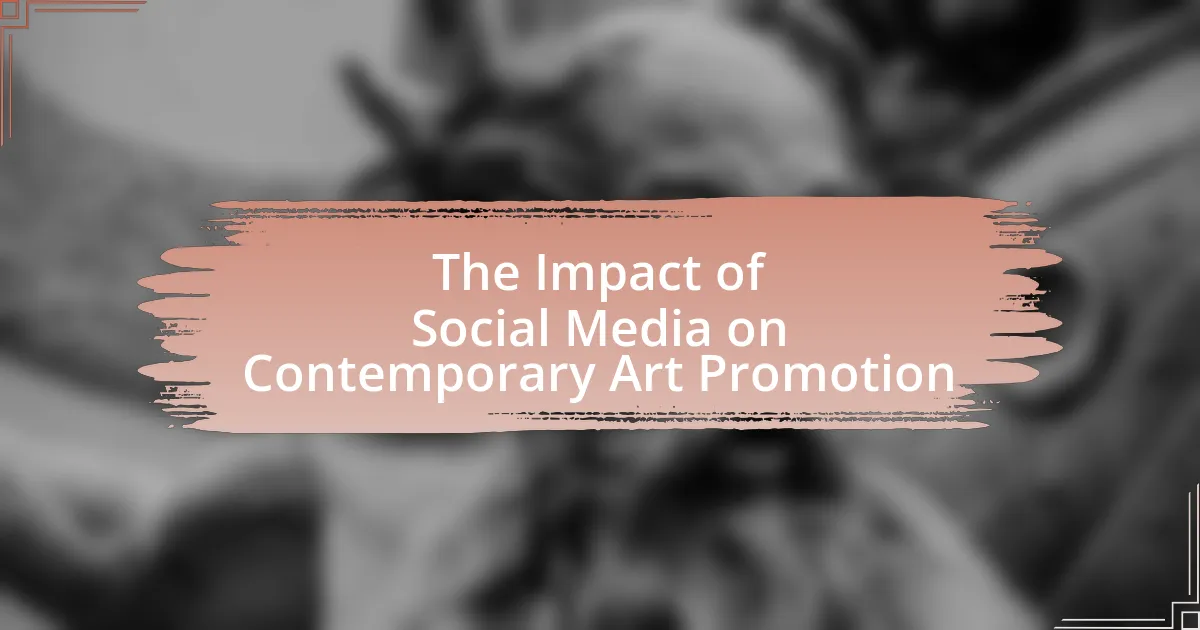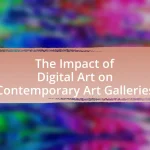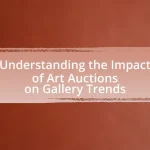The article examines the significant impact of social media on contemporary art promotion, highlighting how platforms like Instagram, Facebook, and TikTok provide artists and galleries with direct access to a global audience. It discusses the transformation of art marketing, emphasizing the democratization of visibility for both emerging and established artists. Key topics include the advantages of social media over traditional promotion methods, strategies for effective self-promotion, the challenges artists face, and the influence of viral trends on art visibility. Additionally, the article explores future trends in social media and art promotion, including the role of emerging technologies and changing audience behaviors.

What is the Impact of Social Media on Contemporary Art Promotion?
Social media significantly enhances the promotion of contemporary art by providing artists and galleries with direct access to a global audience. Platforms like Instagram and Facebook allow artists to showcase their work, engage with followers, and build a personal brand without the need for traditional gallery representation. According to a 2021 survey by Art Basel and UBS, 70% of collectors reported discovering new artists through social media, highlighting its role in expanding visibility. Additionally, social media facilitates real-time interaction and feedback, enabling artists to gauge audience reactions and adapt their marketing strategies accordingly. This democratization of art promotion has transformed how contemporary art is marketed and consumed, making it more accessible to diverse audiences.
How has social media changed the landscape of art promotion?
Social media has transformed art promotion by providing artists with direct access to global audiences, enabling them to showcase their work without traditional gatekeepers. Platforms like Instagram and Facebook allow artists to share their creations instantly, engage with followers, and build personal brands. According to a 2020 survey by Art Basel and UBS, 70% of collectors reported discovering new artists through social media, highlighting its role in expanding visibility and market reach. This shift has democratized art promotion, allowing emerging artists to gain recognition alongside established figures, fundamentally altering the dynamics of the art world.
What are the key social media platforms influencing contemporary art?
The key social media platforms influencing contemporary art are Instagram, Facebook, Twitter, and TikTok. Instagram is particularly significant due to its visual-centric format, which allows artists to showcase their work and connect with audiences globally; as of 2023, it has over 1 billion monthly active users, making it a vital space for art promotion. Facebook facilitates community building and event promotion, while Twitter serves as a platform for real-time discussions and networking among artists and art enthusiasts. TikTok has emerged as a powerful tool for viral art trends, with its short video format enabling artists to reach younger audiences effectively. These platforms collectively shape the visibility and accessibility of contemporary art in the digital age.
How do artists utilize social media for self-promotion?
Artists utilize social media for self-promotion by creating and sharing content that showcases their work, engages with audiences, and builds their personal brand. Platforms like Instagram, Facebook, and Twitter allow artists to reach a global audience, facilitating direct interaction with fans and potential buyers. According to a 2021 survey by Artfinder, 70% of artists reported that social media significantly increased their visibility and sales. By using targeted hashtags, collaborating with other artists, and participating in online art communities, artists can enhance their reach and establish a professional presence in the digital space.
Why is social media important for contemporary artists?
Social media is important for contemporary artists because it provides a platform for direct engagement with audiences and potential buyers. This engagement allows artists to showcase their work, build a personal brand, and create a community around their art. According to a 2021 survey by the National Endowment for the Arts, 70% of artists reported using social media to promote their work, highlighting its significance in reaching wider audiences. Additionally, social media enables artists to receive immediate feedback and foster connections with other creatives, which can lead to collaborative opportunities and increased visibility in the art world.
What advantages does social media provide over traditional art promotion methods?
Social media offers several advantages over traditional art promotion methods, primarily through its ability to reach a global audience instantly and cost-effectively. Unlike traditional methods, which often rely on physical galleries and exhibitions that limit visibility, social media platforms enable artists to showcase their work to millions of potential viewers without geographical constraints. For instance, a study by the Pew Research Center indicates that 72% of adults in the U.S. use some form of social media, providing artists with a vast pool of potential followers and buyers. Additionally, social media allows for real-time engagement and interaction with audiences, fostering a community around the artist’s work, which traditional methods cannot replicate. This interactive aspect can lead to increased visibility and sales, as artists can directly communicate with their audience, receive immediate feedback, and build a loyal following.
How does social media enhance audience engagement for artists?
Social media enhances audience engagement for artists by providing direct communication channels and interactive platforms that foster real-time connections. Artists can share their work instantly, receive immediate feedback, and engage with fans through comments, likes, and shares, which creates a sense of community. According to a 2021 survey by the National Endowment for the Arts, 70% of artists reported increased audience interaction through social media, highlighting its effectiveness in building relationships and expanding reach. This interactive nature allows artists to cultivate a loyal following and encourages participation in their creative processes, further enhancing engagement.
What challenges do artists face when using social media for promotion?
Artists face several challenges when using social media for promotion, including algorithm changes, oversaturation of content, and audience engagement. Algorithm changes on platforms like Instagram and Facebook can limit the visibility of an artist’s posts, making it difficult for them to reach their target audience. Additionally, the oversaturation of content means that artists must compete with countless other creators for attention, which can dilute their message and impact. Furthermore, maintaining consistent audience engagement is challenging, as artists need to balance promotional content with authentic interactions to build a loyal following. These factors collectively hinder effective promotion and can lead to frustration for artists trying to navigate the social media landscape.
How can negative feedback on social media impact an artist’s reputation?
Negative feedback on social media can significantly damage an artist’s reputation by influencing public perception and diminishing their credibility. When users express discontent or criticism online, it can lead to a rapid spread of negative sentiment, often amplified by algorithms that prioritize engagement. For instance, a study by the Pew Research Center found that 64% of Americans believe social media has a mostly negative effect on society, which can extend to individual reputations. Additionally, negative comments can deter potential fans and collaborators, as they may associate the artist with the backlash. This phenomenon illustrates how social media serves as a powerful platform that can either bolster or undermine an artist’s standing in the contemporary art scene.
What are the risks of oversaturation in social media art promotion?
Oversaturation in social media art promotion can lead to diminished visibility and engagement for individual artists. When numerous artworks flood platforms, the audience may experience fatigue, resulting in decreased attention to specific pieces. According to a study by the Pew Research Center, 64% of social media users feel overwhelmed by the amount of content they encounter, which can cause them to disengage from platforms altogether. This disengagement negatively impacts artists’ ability to connect with potential buyers and followers, ultimately hindering their promotional efforts.
How does social media influence art trends and movements?
Social media significantly influences art trends and movements by providing a platform for artists to showcase their work and connect with audiences globally. This democratization of art allows emerging artists to gain visibility without traditional gatekeepers, leading to the rapid spread of new styles and ideas. For instance, platforms like Instagram have been pivotal in popularizing movements such as street art and digital art, as artists can share their creations instantly and engage with followers in real-time. According to a study by the Pew Research Center, 69% of adults in the U.S. use social media, which amplifies the reach of art beyond local galleries and exhibitions, fostering a more diverse and inclusive art community.
What role does social media play in the emergence of new art styles?
Social media significantly influences the emergence of new art styles by providing artists with a platform to showcase their work and connect with a global audience. This accessibility allows for the rapid dissemination of diverse artistic expressions, leading to the blending of styles and the birth of innovative movements. For instance, platforms like Instagram and TikTok have enabled artists to share their creations instantly, fostering trends such as digital art and street art, which gain popularity through viral sharing. Research indicates that 70% of artists believe social media is crucial for their visibility and success, highlighting its role in shaping contemporary art landscapes.
How do viral trends affect the visibility of contemporary artists?
Viral trends significantly enhance the visibility of contemporary artists by rapidly disseminating their work across social media platforms. When a piece of art or an artist becomes part of a viral trend, it can reach millions of users in a short time, leading to increased engagement and exposure. For instance, a study by the Pew Research Center found that 69% of adults in the U.S. use social media, which amplifies the potential audience for artists whose work is shared widely. Additionally, platforms like Instagram and TikTok have algorithms that favor trending content, further elevating the visibility of artists involved in these trends. This phenomenon not only boosts individual artist profiles but also contributes to broader cultural conversations, making contemporary art more accessible and relevant to diverse audiences.
What strategies can artists employ for effective social media promotion?
Artists can employ several strategies for effective social media promotion, including consistent content creation, audience engagement, and leveraging analytics. Consistent content creation involves regularly posting high-quality images, videos, and stories that showcase their work and creative process, which helps maintain visibility and interest among followers. Audience engagement is crucial; artists should interact with their audience through comments, direct messages, and live sessions to build a community and foster loyalty. Additionally, leveraging analytics tools provided by platforms like Instagram and Facebook allows artists to track engagement metrics, understand their audience demographics, and refine their strategies based on data-driven insights. These strategies are supported by research indicating that consistent posting and engagement can significantly increase follower growth and interaction rates, enhancing overall visibility in the competitive social media landscape.
How can artists create engaging content for their social media profiles?
Artists can create engaging content for their social media profiles by showcasing their creative process, sharing behind-the-scenes content, and interacting with their audience. By posting time-lapse videos of their artwork being created, artists can captivate viewers and provide insight into their techniques. Additionally, sharing stories or posts that highlight the inspiration behind their work fosters a deeper connection with followers. Engaging with the audience through comments, polls, and Q&A sessions encourages community involvement and feedback, which can enhance the overall engagement on their profiles. Research indicates that posts with personal narratives and interactive elements receive higher engagement rates, demonstrating the effectiveness of these strategies in promoting contemporary art.
What are best practices for building a following on social media?
To build a following on social media, consistently create high-quality, engaging content that resonates with your target audience. Engaging content encourages shares and interactions, which can significantly increase visibility. According to a study by HubSpot, posts with images receive 94% more views than those without, highlighting the importance of visual appeal. Additionally, utilizing relevant hashtags can enhance discoverability; research indicates that tweets with hashtags receive 2 times more engagement than those without. Regularly interacting with followers through comments and messages fosters community and loyalty, further solidifying your audience base.
How can artists measure the success of their social media promotion?
Artists can measure the success of their social media promotion through key performance indicators (KPIs) such as engagement rates, follower growth, and conversion metrics. Engagement rates, which include likes, shares, and comments, indicate how well the audience interacts with the content, reflecting its resonance and effectiveness. Follower growth shows the increase in audience size over time, suggesting the reach and appeal of the artist’s promotional efforts. Conversion metrics, such as website visits or sales generated from social media links, provide concrete evidence of how social media activities translate into tangible outcomes. According to a study by Hootsuite, posts with higher engagement rates can lead to a 50% increase in audience reach, validating the importance of these metrics in assessing promotional success.
What metrics should artists track to evaluate their social media impact?
Artists should track engagement metrics, follower growth, reach, impressions, and conversion rates to evaluate their social media impact. Engagement metrics, such as likes, comments, and shares, indicate how well content resonates with the audience. Follower growth reflects the expanding reach of the artist’s brand, while reach and impressions measure how many users see the content. Conversion rates, which track actions taken by users, such as visiting a website or purchasing art, provide insight into the effectiveness of social media efforts in driving tangible results. These metrics collectively offer a comprehensive view of an artist’s social media performance and influence.
How can feedback from social media inform an artist’s promotional strategy?
Feedback from social media can significantly inform an artist’s promotional strategy by providing real-time insights into audience preferences and engagement levels. Artists can analyze comments, likes, shares, and overall sentiment to understand which content resonates most with their audience. For instance, a study by the Pew Research Center found that 69% of adults in the U.S. use social media, indicating a vast potential audience for artists to engage with. By leveraging this feedback, artists can tailor their promotional efforts, such as adjusting their content style, timing of posts, and targeted advertising, to better align with audience interests and maximize reach.
What future trends can we expect in social media and art promotion?
Future trends in social media and art promotion will increasingly focus on immersive technologies, such as augmented reality (AR) and virtual reality (VR), to enhance user engagement. These technologies allow artists to create interactive experiences that can be shared on platforms like Instagram and TikTok, attracting wider audiences. For instance, a report by Art Basel and UBS in 2021 indicated that 70% of galleries were using social media to promote their exhibitions, highlighting its growing importance. Additionally, the rise of algorithm-driven content curation will further personalize art promotion, enabling artists to reach targeted demographics more effectively. This shift is supported by data from Statista, which projects that social media advertising spending will reach $227 billion by 2024, indicating a robust investment in digital marketing strategies for art promotion.
How might emerging technologies shape the future of art promotion on social media?
Emerging technologies will significantly shape the future of art promotion on social media by enhancing engagement and accessibility. For instance, augmented reality (AR) allows users to experience art in immersive ways, increasing interaction and interest. According to a study by the Pew Research Center, 72% of adults in the U.S. use social media, providing a vast platform for artists to showcase their work. Additionally, artificial intelligence (AI) can analyze user preferences, enabling targeted marketing strategies that reach specific audiences effectively. This data-driven approach can lead to higher conversion rates for art sales and exhibitions. Furthermore, blockchain technology offers secure methods for verifying ownership and provenance, which can build trust among collectors and buyers in the digital space. These advancements collectively create a more dynamic and efficient environment for art promotion on social media.
What potential changes in audience behavior should artists anticipate?
Artists should anticipate a shift towards increased engagement and interaction from audiences due to the influence of social media. This change is characterized by audiences seeking more personalized experiences and direct communication with artists, as platforms like Instagram and TikTok facilitate real-time feedback and dialogue. Research indicates that 70% of consumers feel more connected to brands when their feedback is acknowledged, highlighting the importance of responsiveness in audience relationships. Additionally, artists may observe a trend of audiences favoring digital art forms and virtual exhibitions, as 60% of art buyers have reported purchasing art online, reflecting a growing comfort with digital transactions. These behavioral changes necessitate that artists adapt their promotional strategies to foster community and leverage digital platforms effectively.
What practical tips can artists follow for successful social media promotion?
Artists can enhance their social media promotion by consistently posting high-quality content that showcases their work. Regularly sharing images or videos of their art, behind-the-scenes processes, and personal stories engages audiences and builds a connection. Utilizing relevant hashtags increases visibility; for instance, using popular art-related tags can attract a broader audience. Engaging with followers through comments and direct messages fosters community and loyalty. Collaborating with other artists or influencers can also expand reach, as partnerships often introduce artists to new audiences. According to a study by Hootsuite, posts with images receive 650% more engagement than text-only posts, underscoring the importance of visual content in social media promotion.


